There’s nothing quite like a classic vanilla cake—its light, fluffy texture and rich, buttery flavor make it a timeless favorite for every occasion. Whether you’re a seasoned baker or just starting out, mastering a homemade vanilla cake is a must. This guide will walk you through every step, from choosing the best ingredients to troubleshooting common baking issues.
In this article, you’ll learn:
- The essential ingredients for a moist vanilla cake recipe.
- A foolproof step-by-step method to bake the perfect cake.
- Tips for crafting the best vanilla buttercream frosting.
- Solutions to common baking problems.
- Fun variations to customize your cake.
So, roll up your sleeves, preheat that oven, and let’s dive into the world of vanilla cake perfection!
Introduction to Vanilla Cake
The Timeless Appeal of Vanilla Cake
Few desserts can match the universal appeal of a simple vanilla cake. Its delicate sweetness and soft crumb make it a staple at birthdays, weddings, and afternoon teas. While some may call it basic, a well-made vanilla cake is anything but ordinary! When baked right, it’s rich yet light, fluffy yet moist, and bursting with a warm, aromatic vanilla flavor.
Vanilla cake also serves as the perfect canvas for creativity. You can dress it up with fresh fruit, fill it with custard, or layer it with decadent buttercream. Whether you prefer a traditional vanilla cake or a modern twist, this recipe is your gateway to a flawless bake.
Why Mastering a Vanilla Cake Recipe is Essential for Bakers
If there’s one cake every baker should master, it’s a homemade vanilla cake. Why? Because once you get it right, you can easily tweak it into a vanilla sponge cake, cupcakes, or even a layered masterpiece. Plus, understanding the science behind a good vanilla cake—how fats, sugars, and leavening agents work together—will make you a better baker overall.
Ready to create the best moist vanilla cake recipe? Let’s start by breaking down the essential ingredients that make this cake truly irresistible!
Essential Ingredients for a Classic Vanilla Cake
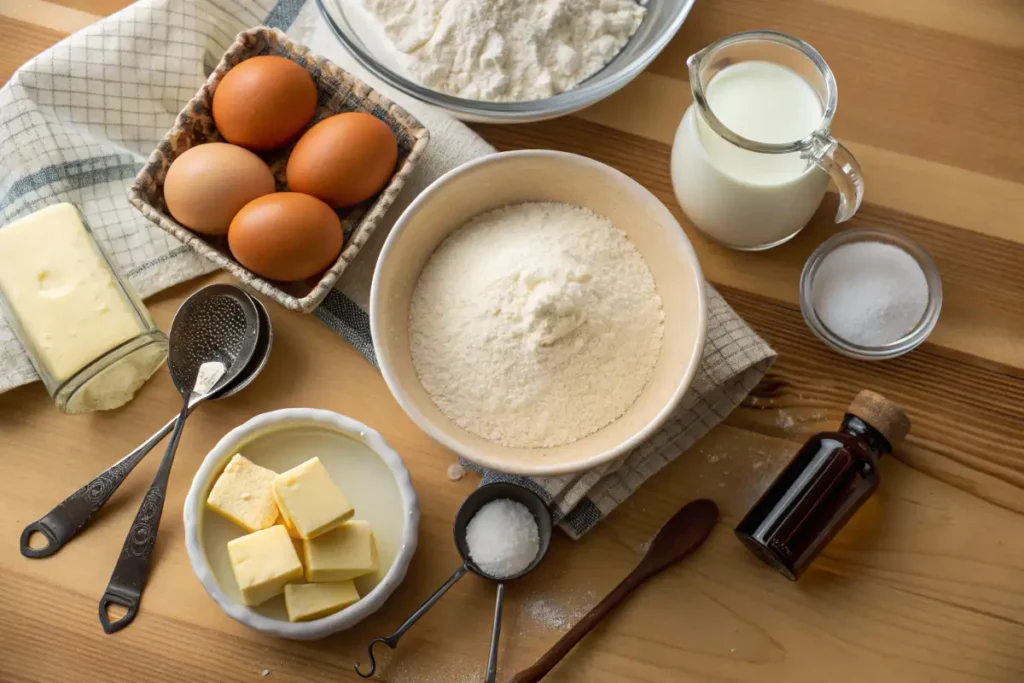
Baking a perfect vanilla cake isn’t just about following a recipe—it’s about understanding what each ingredient does. The right combination creates a cake that’s soft, moist, and full of flavor. Let’s break down the must-have ingredients for a fail-proof vanilla cake recipe.
Flour Selection: All-Purpose vs. Cake Flour
Flour is the base of any cake, but not all flours are the same. All-purpose flour is common and gives structure, but if you want a softer, lighter texture, cake flour is the way to go. It has less protein, which means less gluten, resulting in a tender crumb. If you don’t have cake flour, don’t worry—you can make your own by replacing 2 tablespoons of flour with cornstarch for every cup.
The Role of Sugar: Granulated vs. Caster
Sugar doesn’t just sweeten your cake—it also helps trap air, creating a light, fluffy texture. Granulated sugar is the standard choice, but caster sugar (a finer version) dissolves faster and blends better into the batter. Whichever you use, make sure to cream it well with butter for the best results.
Choosing the Right Fats: Butter, Oil, or Both?
Butter adds rich flavor, while oil keeps cakes moist. Some vanilla cake recipes use only butter for taste, but adding a little oil makes the cake softer and prevents dryness. If you’re aiming for extra moisture, consider using a mix of both.
The Importance of Fresh Leavening Agents: Baking Powder and Baking Soda
These two ingredients are what make the cake rise. Baking powder is a complete leavening agent, while baking soda needs something acidic (like buttermilk) to work. Always check expiration dates—old leavening agents won’t give your cake the lift it needs!
Dairy Choices: Milk, Buttermilk, or Sour Cream?
Dairy plays a key role in making the cake moist and tender. Regular whole milk is fine, but for extra softness, buttermilk or sour cream is even better. The acidity helps break down gluten, giving you a smoother, softer crumb.
Vanilla Extracts and Essences: Pure vs. Imitation
Since vanilla is the star of the show, using a good-quality vanilla extract is essential. Pure vanilla extract gives the best flavor, but if you’re on a budget, imitation vanilla works too. Want an even deeper vanilla taste? Try adding vanilla bean paste for those beautiful black specks and a richer aroma.
Step-by-Step Guide to Making the Best Vanilla Cake
Now that we have the best ingredients, it’s time to bring them together. Follow this vanilla cake recipe step by step, and you’ll have a delicious, bakery-quality cake every time.
Preparing Your Baking Tools and Equipment
Before you start, gather everything you need: measuring cups, mixing bowls, a stand or hand mixer, a spatula, and cake pans. Grease and line your pans with parchment paper to prevent sticking. Also, preheat your oven—starting with a hot oven ensures even baking.
Mixing Techniques: Creaming Butter and Sugar
One of the secrets to a light, fluffy cake is creaming butter and sugar properly. Beat them together for at least 3-5 minutes until the mixture turns pale and fluffy. This step traps air, helping the cake rise beautifully.
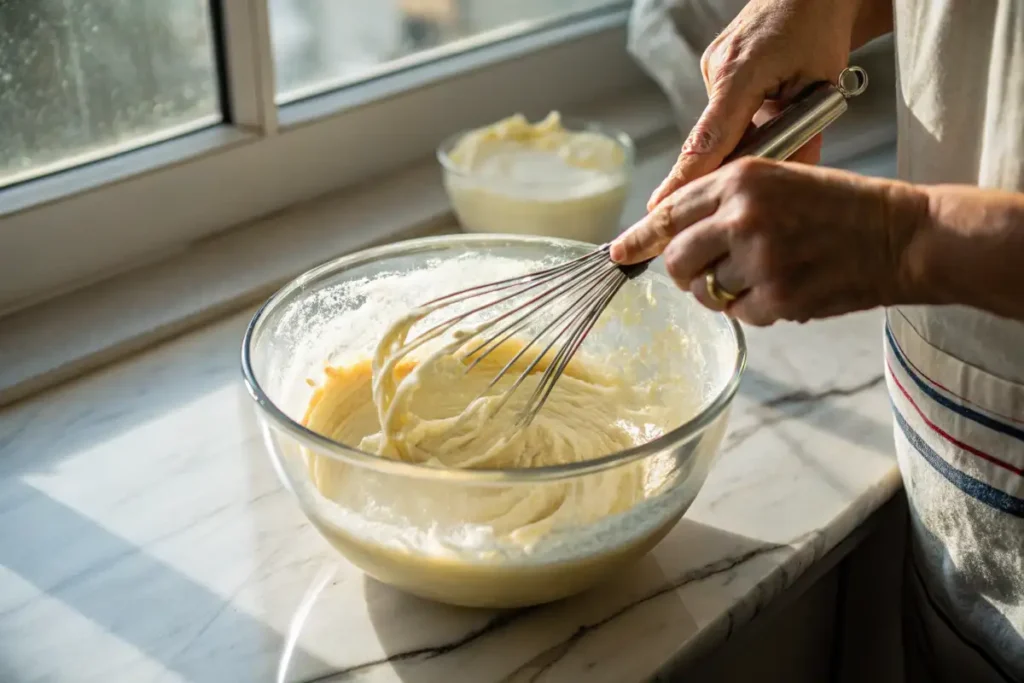
Incorporating Eggs: Whole Eggs vs. Egg Whites
Eggs add structure and richness. Most recipes use whole eggs, but if you want a lighter texture, you can replace some of the yolks with extra whites. Add eggs one at a time, mixing well after each addition to avoid curdling.
Alternating Dry and Wet Ingredients: Achieving the Perfect Batter Consistency
Instead of dumping everything in at once, add your dry ingredients (flour, baking powder, and salt) and wet ingredients (milk, vanilla extract) in stages. Start with dry, then add wet, and repeat. This prevents overmixing, which can make the cake dense.
Pouring and Leveling the Batter in Cake Pans
Once your batter is smooth, divide it evenly between your prepared cake pans. Use a spatula to smooth the tops. For an even bake, tap the pans lightly on the counter to remove air bubbles.
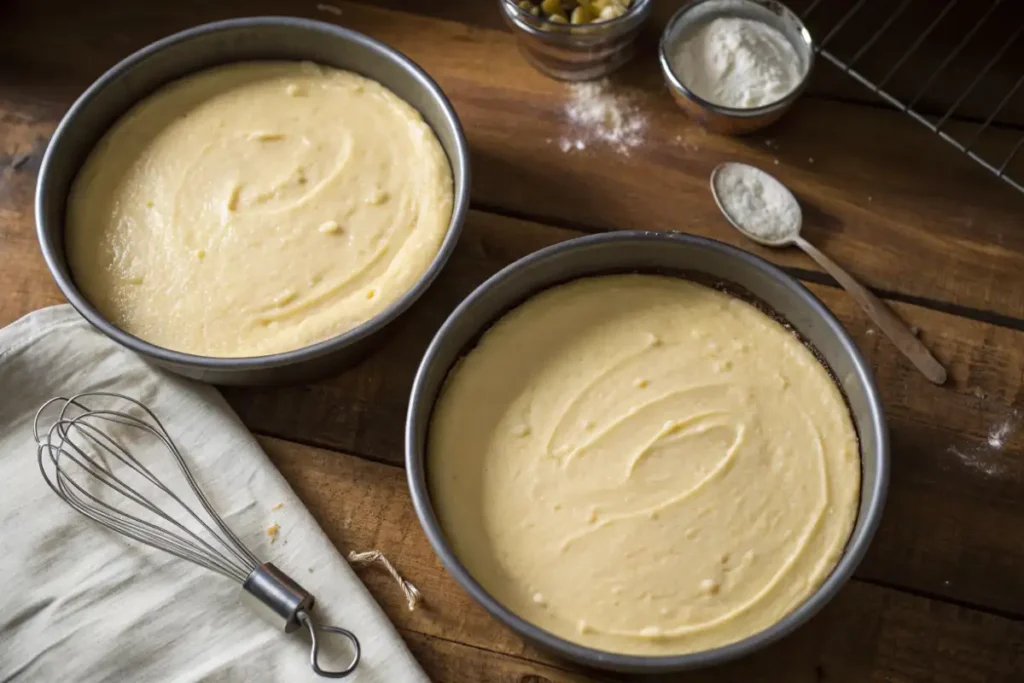
Baking Time and Temperature: Ensuring Even Cooking
Place the cakes in the center of your oven and bake at 350°F (175°C) for about 30-35 minutes. Avoid opening the oven door too soon—this can cause the cake to sink. Instead, check at the 30-minute mark by inserting a toothpick in the center. If it comes out clean, your cake is ready!
Testing for Doneness: Toothpick Test and Other Methods
Not sure if your cake is fully baked? Here’s how to check:
- Insert a toothpick in the middle—if it comes out clean or with a few crumbs, it’s done.
- Lightly press the top—if it springs back, it’s ready.
- Check the edges—if they pull slightly away from the pan, the cake is done.
Once baked, let the cakes cool in the pan for 10 minutes, then transfer them to a wire rack. This prevents soggy bottoms and keeps the texture just right.
With these steps, your homemade vanilla cake will turn out perfect every time! Next up, we’ll dive into making the best buttercream frosting to complement your delicious cake
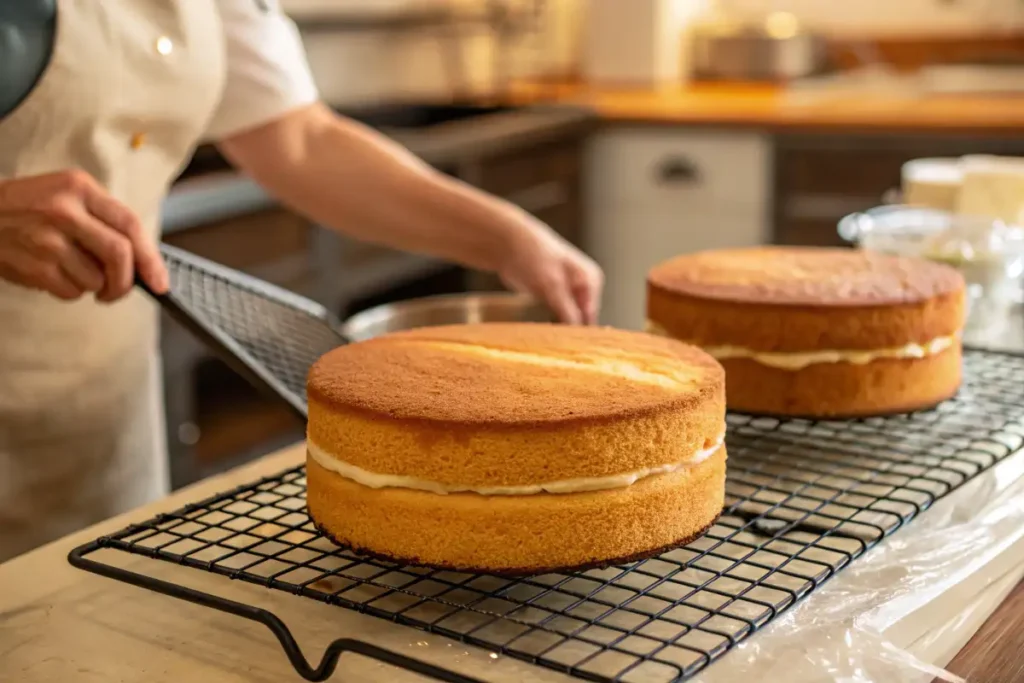
Crafting the Perfect Vanilla Buttercream Frosting
A vanilla cake recipe isn’t complete without a luscious buttercream frosting. This creamy topping adds sweetness and a smooth texture, making each bite delightful. Let’s explore how to make the perfect vanilla buttercream.
Essential Ingredients for Silky Smooth Frosting
To create a rich frosting, you’ll need:
- Unsalted Butter: Provides a creamy base. Ensure it’s at room temperature for easy mixing.
- Powdered Sugar: Also known as confectioners’ sugar, it dissolves quickly, giving the frosting a smooth finish.
- Vanilla Extract: Adds that classic vanilla flavor. Opt for pure extract for the best taste.
- Heavy Cream or Milk: Helps achieve the desired consistency, making the frosting spreadable.
Mixing Techniques: Achieving the Ideal Consistency
Begin by beating the butter until it’s light and fluffy. Gradually add the powdered sugar, one cup at a time, mixing well after each addition. This method prevents a grainy texture. Once combined, pour in the vanilla extract and a tablespoon of heavy cream or milk. Continue beating until the frosting is smooth and airy. If it’s too thick, add more cream or milk, a teaspoon at a time, until you reach the perfect consistency.
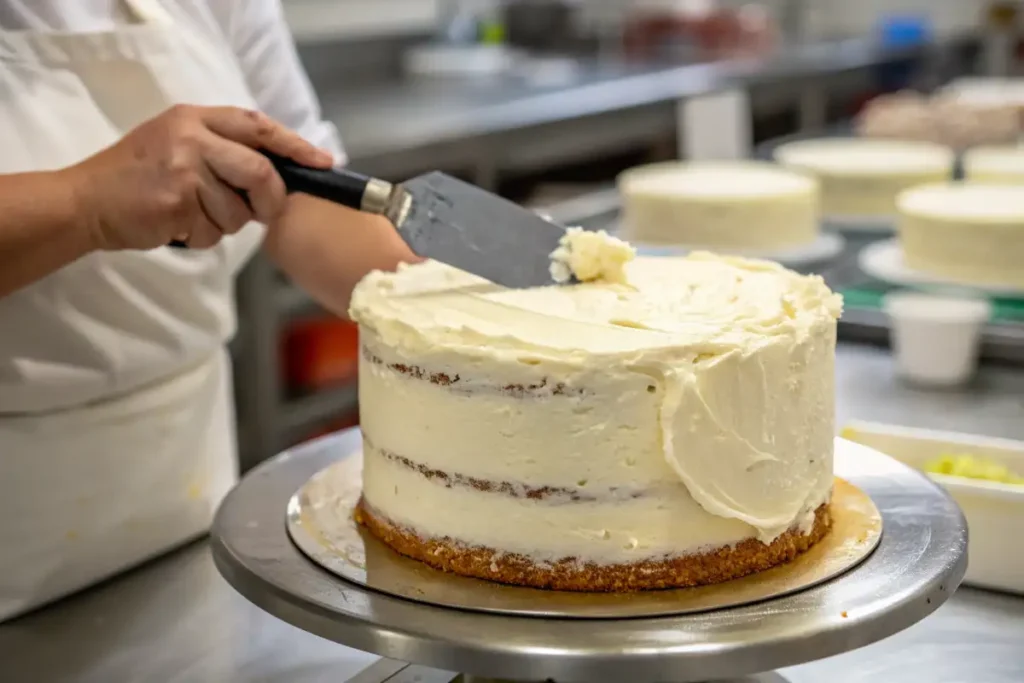
Flavor Enhancements: Adding Vanilla Beans or Other Extracts
For a more intense vanilla flavor, consider incorporating vanilla bean seeds. Simply split a vanilla bean pod and scrape out the seeds, then mix them into the frosting. This addition not only boosts flavor but also adds appealing specks throughout. Alternatively, you can experiment with other extracts, like almond or coconut, to give your frosting a unique twist.
Coloring Your Frosting: Natural vs. Artificial Options
If you wish to color your frosting, you have two main options:
- Natural Coloring: Ingredients like beet juice (for pink) or matcha powder (for green) can provide subtle hues without artificial additives.
- Artificial Coloring: Food coloring gels offer vibrant shades and are easy to use. Add a few drops at a time until you achieve the desired color.
Remember, a well-crafted buttercream not only complements your vanilla cake but also enhances its overall appeal.
Decorating and Serving Your Vanilla Cake
Once your vanilla cake is baked and your buttercream is ready, it’s time to assemble and decorate. Presentation plays a significant role in making your cake enticing. Let’s delve into some techniques to make your cake stand out.
Basic Decorating Techniques: Spreading and Piping Frosting
Start by placing one cake layer on a serving plate. Spread a generous amount of buttercream on top, then place the second layer over it. Apply a thin layer of frosting around the entire cake—a process known as the crumb coat. This layer traps any loose crumbs, ensuring a smooth final finish. After chilling the cake for about 15 minutes to set the crumb coat, apply a thicker layer of frosting, smoothing it with an offset spatula. For added flair, use a piping bag fitted with decorative tips to create rosettes, swirls, or other designs on the cake’s surface.
Advanced Decorations: Fondant, Ganache, and Edible Flowers
For those looking to elevate their cake’s appearance:
- Fondant: This pliable icing can be rolled out and draped over the cake for a sleek, polished look. It can also be molded into various shapes and figures for added decoration.
- Ganache: A mixture of chocolate and cream, ganache can be poured over the cake to create a glossy finish or whipped to a spreadable consistency for frosting.
- Edible Flowers: Fresh or candied edible flowers can add a touch of elegance and natural beauty to your cake.
Serving Suggestions: Pairing with Beverages and Occasion-Based Presentation
When it comes to serving your vanilla cake, consider the occasion. For a casual gathering, simple slices on dessert plates may suffice. For more formal events, garnish each slice with a dollop of whipped cream, a drizzle of caramel, or a sprinkle of powdered sugar. Pairing your cake with complementary beverages can enhance the experience. A cup of hot tea, a glass of milk, or even a sweet dessert wine can complement the cake’s flavors beautifully.
By paying attention to these details, you’ll ensure that your vanilla cake is not only delicious but also a feast for the eyes.
For more delightful recipes and baking tips, be sure to check out our other articles.
Troubleshooting Common Vanilla Cake Issues
Even with the best vanilla cake recipe, things don’t always go as planned. Cakes can sink, turn out dry, or brown too much. But don’t worry! Here’s how to fix the most common baking problems.
Why Did My Cake Sink in the Middle?
A sinking cake can be frustrating, but it usually happens due to one of these reasons:
- The oven door was opened too early, letting cool air in.
- The cake was underbaked, meaning the center didn’t set properly.
- Too much leavening (baking powder or baking soda) caused the cake to rise too fast, then collapse.
Fix: Always bake at the right temperature and check doneness using the toothpick test before removing the cake from the oven.
Dealing with Dry or Crumbly Texture
If your cake turns out dry, the most common causes include:
- Overbaking: Leaving it in the oven too long removes moisture.
- Not enough fat: Butter and oil help keep cakes soft.
- Too much flour: Measuring flour incorrectly can make the cake dense and dry.
Fix: Reduce baking time slightly and use a mix of butter and oil for better moisture. Also, spoon flour into the measuring cup instead of scooping it directly from the bag.
Preventing Overbrowning or Undercooking
Sometimes, the edges of a cake brown too fast while the inside remains raw. This often happens when:
- The oven temperature is too high.
- The cake pan is too dark, causing excess heat absorption.
Fix: Lower the oven temperature by 25°F (about 15°C) and use light-colored cake pans for even baking.
Achieving a Flat Top: Avoiding Domed Cakes
A domed cake can make frosting tricky. This happens when the oven is too hot, forcing the cake to rise quickly in the center.
Fix: Bake at a lower temperature (325°F instead of 350°F) and use cake strips around the pans to keep the sides cooler, promoting even rising.
FAQs
Bakers often have questions when trying a vanilla cake recipe. Here are some of the most common ones.
Can I Substitute Ingredients in a Vanilla Cake Recipe?
Yes, but substitutions can change the texture and taste. For example:
- Flour: Use cake flour instead of all-purpose for a lighter cake.
- Butter: Swap with vegetable oil for extra moisture.
- Sugar: Try brown sugar for a hint of caramel flavor.
Always test small batches when making major changes.
How Do I Store a Vanilla Cake to Keep It Fresh?
To keep your cake fresh:
- At room temperature: Store in an airtight container for up to 3 days.
- In the fridge: Wrap tightly in plastic wrap for up to a week.
- In the freezer: Freeze unfrosted layers for up to 3 months.
Can I Make a Vanilla Cake Ahead of Time?
Absolutely! Bake the cake layers a day before and wrap them well. Frosting can be stored in the fridge, then whipped again before spreading.
What’s the Best Way to Freeze Vanilla Cake?
Wrap each cake layer in plastic wrap and then aluminum foil to prevent freezer burn. Thaw at room temperature before frosting.
By following these tips, your vanilla cake will always turn out amazing! Next, let’s explore some fun variations to customize your recipe.
Exploring Variations of Vanilla Cake
A vanilla cake recipe is incredibly versatile. While the classic version is always a hit, you can easily tweak it to match different dietary needs or add exciting flavors. Let’s explore some fun variations.
Gluten-Free Vanilla Cake Options
Want to make your cake gluten-free? It’s easy! Simply swap all-purpose flour for a gluten-free flour blend. Look for one that contains xanthan gum, which helps mimic the structure of regular flour. Also, be sure to check your baking powder and vanilla extract for hidden gluten.
Tip: Gluten-free cakes tend to dry out faster, so adding an extra tablespoon of oil or sour cream can keep it moist.
Vegan Vanilla Cake Recipes
For a dairy-free, egg-free version, follow these simple swaps:
- Butter → Coconut oil or vegan butter
- Milk → Almond, soy, or oat milk
- Eggs → Applesauce, mashed banana, or flaxseed meal mixed with water
Vegan cakes can sometimes be denser, but using baking soda and vinegar together helps create a lighter texture.
Incorporating Fillings: Fruit, Custard, and More
Want to elevate your homemade vanilla cake? Add a delicious filling! Here are a few ideas:
- Fruit Jam: Spread raspberry, strawberry, or apricot jam between layers.
- Pastry Cream: A rich, vanilla-infused custard makes a decadent filling.
- Chocolate Ganache: For a surprise chocolatey twist, drizzle some ganache inside.
Transforming Vanilla Cake into Cupcakes or Layer Cakes
This vanilla cake recipe works just as well for cupcakes! Simply scoop the batter into lined muffin tins and bake for about 18-20 minutes. For layer cakes, double the recipe and stack multiple layers with frosting in between.
No matter how you modify it, vanilla cake is always a winner!
Conclusion
Baking a vanilla cake recipe from scratch is more than just following steps—it’s an art. When you use the right ingredients, mix carefully, and follow key baking techniques, you’ll always end up with a soft, moist, and flavorful cake.
One of the best things about vanilla cake is its versatility. You can keep it simple for everyday treats or dress it up for special occasions. With endless frosting options, decorative styles, and variations like gluten-free or vegan, there’s a vanilla cake for everyone.
If you ever run into baking issues, don’t be discouraged! Mistakes are part of learning. Whether your cake sinks, dries out, or turns too dark, there’s always a fix. Just keep practicing, and soon, you’ll perfect your go-to vanilla cake recipe.
Now it’s your turn! Try this recipe, experiment with flavors, and make it your own. Whether you enjoy it plain, layered with frosting, or filled with fruit, nothing beats a homemade vanilla cake baked with love.
For more delicious baking ideas, check out our other recipes!
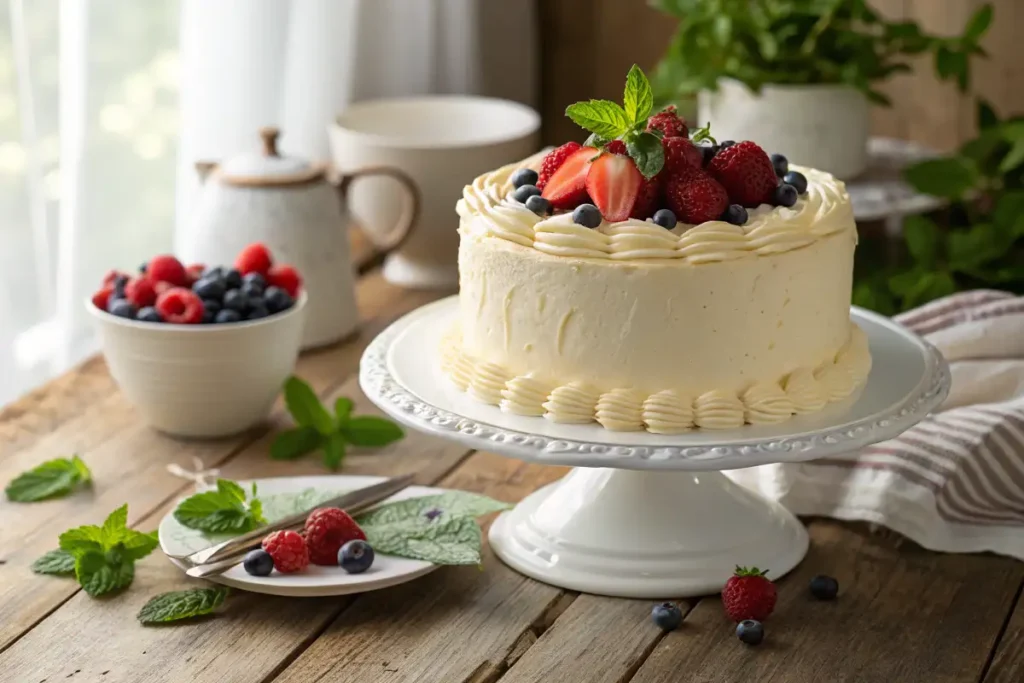

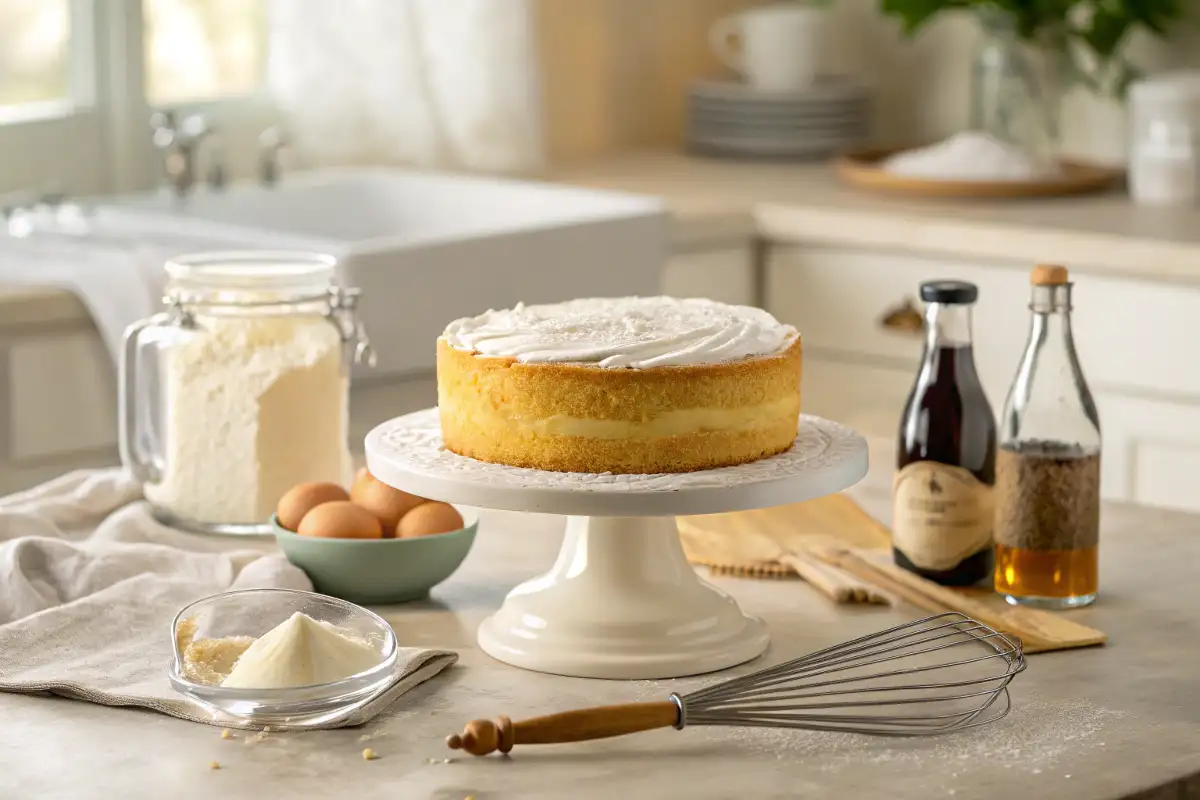
2 thoughts on “The Ultimate Guide to Baking a Perfect Vanilla Cake”